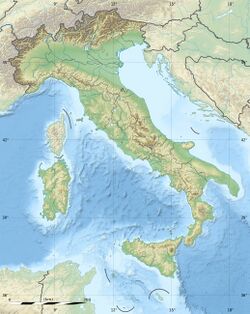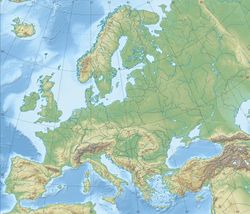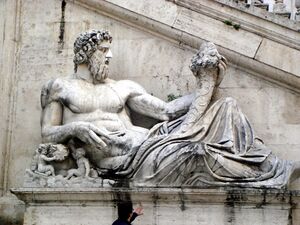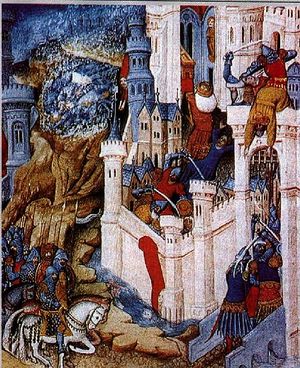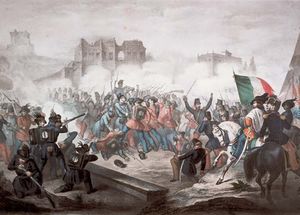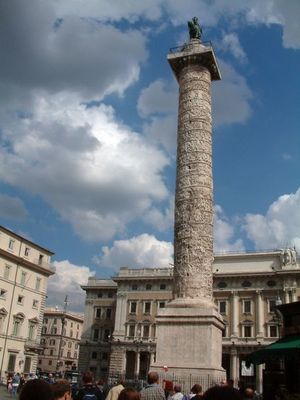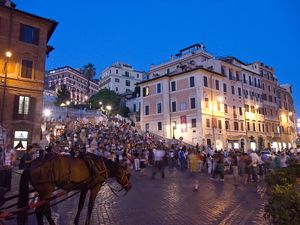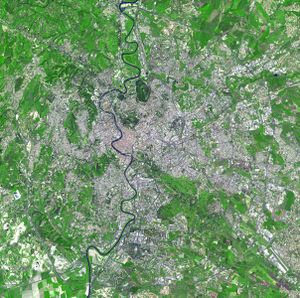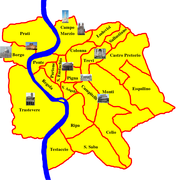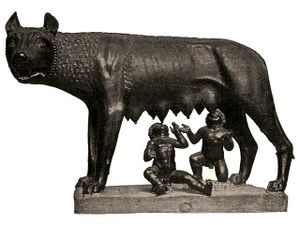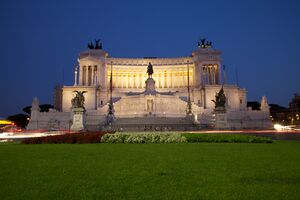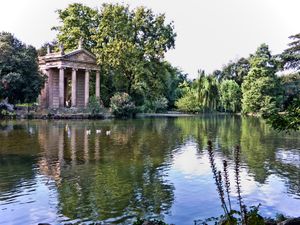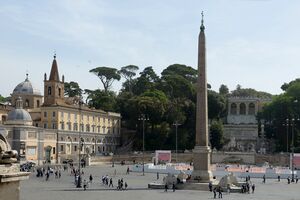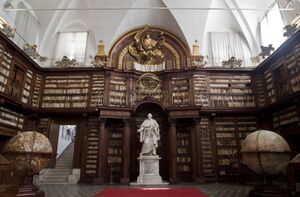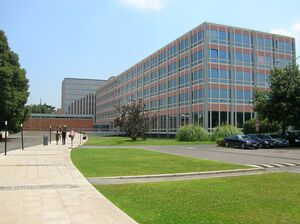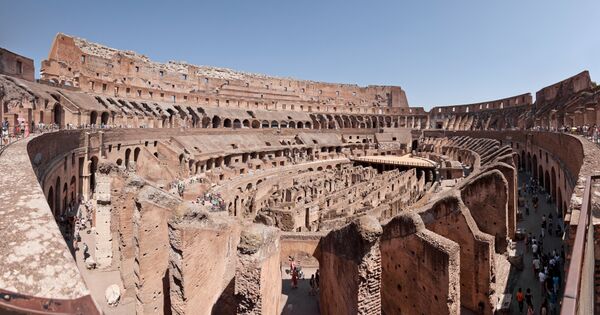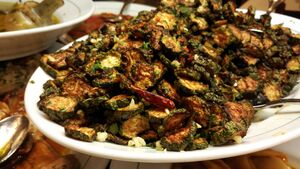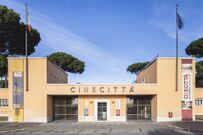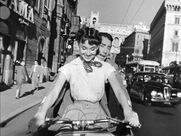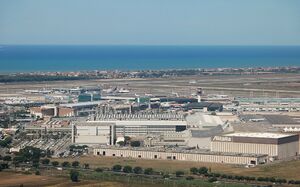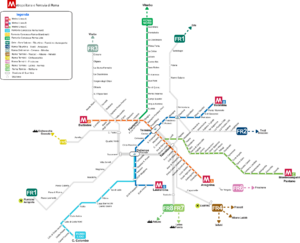روما
Rome
Roma (إيطالية) | |||||||||||||||
|---|---|---|---|---|---|---|---|---|---|---|---|---|---|---|---|
| Roma Capitale | |||||||||||||||
مع عقارب الساعة من أعلى: الكولوسيوم؛ بازيليكا القديس بطرس؛ Castel Sant'Angelo؛ Ponte Sant'Angelo؛ نافورة تريفي؛ و الپانثيون. النقر على صورة في الملصق سيجعل المتصفح لتحميل المقال المناسب. | |||||||||||||||
| أصل الاسم: لعلها إتروسكية: Rumon, lit. 'نهر' | |||||||||||||||
| الكنية: | |||||||||||||||
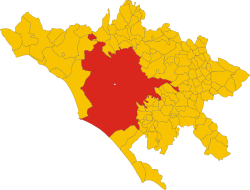 أراضي مدينة (روما كاپيتالى، بالأحمر) داخل مدينة روما العمرانية (Città Metropolitana di Roma, in yellow). النقطة البيضاء في المركز هي مدينة الڤاتيكان. | |||||||||||||||
| الإحداثيات: 41°53′36″N 12°28′58″E / 41.89333°N 12.48278°E | |||||||||||||||
| البلد | إيطاليا[أ] | ||||||||||||||
| الإقليم | لاتسيو | ||||||||||||||
| المدينة العمرانية | روما العاصمة | ||||||||||||||
| تأسست | 753 ق.م. | ||||||||||||||
| أسسها | الملك رومولوس (الأسطوري)[1] | ||||||||||||||
| الحكومة | |||||||||||||||
| • النوع | عمدة قوي–مجلس | ||||||||||||||
| • العمدة | روبرتو گوالتييري (PD) | ||||||||||||||
| • المجلس التشريعي | مجلس الكاپيتولين | ||||||||||||||
| المساحة | |||||||||||||||
| • Total | 1٬285 كم² (496٫3 ميل²) | ||||||||||||||
| المنسوب | 21 m (69 ft) | ||||||||||||||
| التعداد (31 December 2019) | |||||||||||||||
| • الترتيب | الأولى في إيطاليا (الثالثة في الاتحاد الأوروبي) | ||||||||||||||
| • الكثافة | 2٬236/km2 (5٬790/sq mi) | ||||||||||||||
| • Comune | 2٬860٬009[2] | ||||||||||||||
| • مدينة عمرانية | 4٬342٬212[3] | ||||||||||||||
| صفة المواطن | إيطالية: romano(i) (مذكر)، romana(e) (مؤنث) إنگليزية: Roman(s) | ||||||||||||||
| منطقة التوقيت | UTC+1 (CET) | ||||||||||||||
| • الصيف (التوقيت الصيفي) | UTC+2 (CEST) | ||||||||||||||
| CAP code(s) | 00100; 00118 to 00199 | ||||||||||||||
| مفتاح الهاتف | 06 | ||||||||||||||
| الموقع الإلكتروني | comune.roma.it | ||||||||||||||
| |||||||||||||||
روما (بالإيطالية واللاتينية: Roma ؛ النطق بالإيطالية: [ˈroːma]) هي عاصمة إيطاليا وأكبر مدنها. تقع في وسط إيطاليا على ضفاف نهر التيفيري و يبلغ عدد سكانها حوالي 2,860,009 نسمة في 1,285 km2 (496.1 sq mi).[2] وهي عاصمة مقاطعة روما حوالي 3,615,972 نسمة ، وأيضا عاصمة إقليم لاتسيو حوالي 5,270,000. Rome is the country's most populated comune and the third most populous city in the European Union by population within city limits. The Metropolitan City of Rome, with a population of 4,355,725 residents, is the most populous metropolitan city in Italy.[3] Its metropolitan area is the third-most populous within Italy.[4] Rome is located in the central-western portion of the Italian Peninsula, within Lazio (Latium), along the shores of the Tiber. Vatican City (the smallest country in the world)[5] is an independent country inside the city boundaries of Rome, the only existing example of a country within a city. Rome is often referred to as the City of Seven Hills due to its geographic location, and also as the "Eternal City".[6] Rome is generally considered to be the "cradle of Western civilization and Christian culture", and the centre of the Catholic Church.[7][8][9]
Rome's history spans 28 centuries. While Roman mythology dates the founding of Rome at around 753 BC, the site has been inhabited for much longer, making it a major human settlement for almost three millennia and one of the oldest continuously occupied cities in Europe.[10] The city's early population originated from a mix of Latins, Etruscans, and Sabines. Eventually, the city successively became the capital of the Roman Kingdom, the Roman Republic and the Roman Empire, and is regarded by many as the first-ever Imperial city and metropolis.[11] It was first called The Eternal City (لاتينية: Urbs Aeterna; إيطالية: La Città Eterna) by the Roman poet Tibullus in the 1st century BC, and the expression was also taken up by Ovid, Virgil, and Livy.[12][13] Rome is also called "Caput Mundi" (Capital of the World). After the fall of the Empire in the west, which marked the beginning of the Middle Ages, Rome slowly fell under the political control of the Papacy, and in the 8th century, it became the capital of the Papal States, which lasted until 1870. Beginning with the Renaissance, almost all popes since Nicholas V (1447–1455) pursued a coherent architectural and urban programme over four hundred years, aimed at making the city the artistic and cultural centre of the world.[14] In this way, Rome became first one of the major centres of the Renaissance[15] and then the birthplace of both the Baroque style and Neoclassicism. Famous artists, painters, sculptors, and architects made Rome the centre of their activity, creating masterpieces throughout the city. In 1871, Rome became the capital of the Kingdom of Italy, which, in 1946, became the Italian Republic.
In 2019, Rome was the 14th most visited city in the world, with 8.6 million tourists, the third most visited city in the European Union, and the most popular tourist destination in Italy.[16] Its historic centre is listed by UNESCO as a World Heritage Site.[17] The host city for the 1960 Summer Olympics, Rome is also the seat of several specialised agencies of the United Nations, such as the Food and Agriculture Organization (FAO), the World Food Programme (WFP) and the International Fund for Agricultural Development (IFAD). The city also hosts the Secretariat of the Parliamentary Assembly of the Union for the Mediterranean[18] (UfM) as well as the headquarters of many international businesses, such as Eni, Enel, TIM, Leonardo, and banks such as BNL. Numerous companies are based within Rome's EUR business district, such as the luxury fashion house Fendi located in the Palazzo della Civiltà Italiana. The presence of renowned international brands in the city has made Rome an important centre of fashion and design, and the Cinecittà Studios have been the set of many Academy Award–winning movies.[19]
أصل الاسم
According to the Ancient Romans' founding myth,[20] the name Roma came from the city's founder and first king, Romulus.[1]
However, it is possible that the name Romulus was actually derived from Rome itself.[21] As early as the 4th century, there have been alternative theories proposed on the origin of the name Roma. Several hypotheses have been advanced focusing on its linguistic roots which however remain uncertain:[22]
- From Rumon or Rumen, archaic name of the Tiber, which in turn is supposedly related to the Greek verb ῥέω (rhéō) 'to flow, stream' and the Latin verb ruō 'to hurry, rush';[ب]
- From the Etruscan word 𐌓𐌖𐌌𐌀 (ruma), whose root is *rum- "teat", with possible reference either to the totem wolf that adopted and suckled the cognately named twins Romulus and Remus, or to the shape of the Palatine and Aventine Hills;
- From the Greek word ῥώμη (rhṓmē), which means strength.[ت]
التاريخ
التاريخ القديم
تقول الأساطير بأن روما تأسست على يد رومولوس، بمساعدة أخيه ريموس، الذان كانت امهما هى ريا سليفيا كاهنه في معبد الاله فيستا الهه الموقد وفى يوم عند كانت ذاهبه إلى بستان الاله مارس ظهر لها في هيئه بشريه واغتصبها وكان من الفروض ان كاهنات المعبد عذراوات فسجنت ووضع الطفلان في صندوق والقى في النهر حتى استقر الصندوق على الشاطىء فراتهما ذئبه كانت قد وضعت فارضعتهما . قتل أخيه وأصبح أول ملك على المدينة. تشكلت الشعوب الرومانية القديمة في القرن الثامن أو التاسع قبل الميلاد، حينما أتت قبائل شمالية إلى عمق شبه الجزيرة الإيطالية لتستقر عند نهر التيبر. لعدة قرون على مر الزمن، كانت روما أهم مدينة في العالم الغربي، عندما كانت عاصمة الإمبراطورية الرومانية. مع ظهور الدعوة المسيحية وانتشارها، أصبحت روما مركزا للدين المسيحي ومقر باباوات الكنيسة الكاثوليكية. في العصور الوسطى وخاصة بعد انحطاط الإمبراطورية الرومانية، دخلت روما عهدا مظلما. سطع نجمها مجددا في عصر النهضة وأصبحت من خلال فناني وأدباء إيطاليا عاصمة سياسية لأوروبا.
العصور الوسطى
أصبحت روما المركز الرسمي للكنيسة النَّصرانيَّة، وزاد البابا من سلطته السياسية خلال القرن الثامن الميلادي. وعندما هاجم اللمبارديون روما، طلب البابا ستيفن الثاني المساعدة من بيبين ملك الفرنجة، الذي أنقذ روما مرتين، وفي 756م، أعطى المدينة والمناطق المجاورة للبابا. كسبت روما، التي كان عدد سكانها 20,000 نسمة فقط، معنى جديدا منذ عهد ببين كعاصمة للدولة الكنائسية (Patrimonium Petri) وأضحت أهم وجهة للحجاج المسيحيين إلى جانب القدس وسانتياغو دي كومبستيلا. توج كارل الكبير في عام 800 على رأس الإمبراطورية الرومانية المقدسة على يد البابا ليو الثالث. بين 843 و849 فشلت محاولات المسلمين فتح المنطقة.
عصر الإقطاع والنهضة
بعد القرن التاسع الميلادي، تدهورت روما بسبب المعارك بين الملوك والأمراء. وحاول الكثير من حكام أوروبا السيطرة على السلطة البابوية، عن طريق التدخل في الانتخابات. وفي عام 1305م وبتدخل ملك فرنسا فيليب الرابع، انتخب رئيس الأساقفة الفرنسي كليمنت الخامس بابا. وقام بنقل محكمته إلى أفنيون في فرنسا، ولكنها أعيدت إلى روما عام 1377م. انظر: البابا .
في تلك الفترة ثار كولادي رينزي ـ أحد المتحمسين الإيطاليين ـ ضد الأشراف، وأسس جمهورية ديمقراطية، عام 1347م. ولكنه أصبح حاكمًا قاسيًا، وقُتل في حادث شغب. أصبحت روما من المدن المتقدمة أثناء عصر النهضة. وفي عام 1527م، دمّرت الجيوش الألمانية والأسبانية المدينة ونهبت ثرواتها، وقتلت آلاف السكان، ثم بدأت عملية إعادة بناء روما في القرنين السادس عشر والسابع عشر الميلاديين، وشيّد الباباوات عدة بنايات ضخمة، ووظفوا عددًا من الرسامين والنحاتين منهم مايكل أنجلو، لتصميمها وتزيينها.
القرن التاسع عشر
في عام 1798م، احتل الفرنسيون بقيادة نابليون إيطاليا. وفي عام 1809م، أنهى نابليون سلطة البابا السياسية، وأعلن أن روما هي المدينة الثانية في إمبراطوريته بعد باريس. وجعل البابوية جزءًا من إمبراطوريته حتى أعيدت إلى روما بعد هزيمته عام 1815م. وفي أوائل القرن التاسع عشر الميلادي، عارض البابا الحركات المطالبة بالوحدة والحرية. وفي 1848م، جعل الثوار روما جمهورية، فهرب البابا بيوس التاسع من المدينة. واحتل الجيش الفرنسي روما عام 1849م، وأعادوا سيطرة البابا عام 1850م. وفي عام 1861م، لم تكن روما جزءًا من مملكة إيطاليا الموحدة في عهد الملك فكتور إيمانويل الثاني. وحاول بعض الإيطاليين السيطرة على روما، فمنعهم الفرنسيون، وبعد انسحاب الفرنسيين عام 1870م، دخل الملك فكتور روما، وأنهى سلطة البابا السياسية، وجعل روما عاصمته عام 1871م. وبقي الوضع على حاله، حتى عام 1929م، عندما اعتُرِف بمدينة الفاتيكان دولة مستقلة، اعترفت الكنيسة الرومانية الكاثوليكية رسميًا بأن روما عاصمة إيطاليا.
القرن العشرون
توسعت روما في القرن العشرين؛ فأنشئت الطرق والبنايات الكبيرة، وتم ترميم كثير من الآثار والتماثيل.
سيطر بنيتو موسوليني على إيطاليا في العشرينيات والثلاثينيات من القرن العشرين، واتبع خطة سيئة لإعمار المدينة سببت مشكلات حديثة في المدينة، كازدحام الشوارع بالسيارات، أتم موسوليني بناء جامعة روما عام 1935، وبدأ في إنشاء محطة السكك الحديدية المركزية عام 1938. لكن البناء توقف بسبب الحرب العالمية الثانية (1939-1945). لم تعانِ روما من الدمار كثيرًا خلال الحرب، وذلك لرغبة الطرفين المتحاربين في الحفاظ على حياة البابا بيوس الثاني عشر. وبعد الحرب، استمر العمل في محطة السكك الحديدية حيث انتهى العمل بها حسب خطة جديدة عام 1950م. بدأ موسوليني أيضًا في إنشاء مجمع بنايات ضخم، وتوقف العمل به بسبب الحرب العالمية الثانية، ثم بدأ المشروع عام 1951. ويحتوي المجمع على بنايات حكومية ومكاتب خاصة، وبنايات سكنية، ومتاحف، ومطاعم. وفي عام 1955 ربط المجمع بخط سكة حديدية مع المحطة الرئيسية. أجريت بعض النشاطات الرياضية للألعاب الأوليمبية الصيفية عام 1960 في الإستاد الرياضي بجوار المجمع. انتهى العمل في المجمع عام 1976. وفي أوائل الثمانينيات من القرن العشرين الميلادي، تم ترميم عدة تماثيل وآثار منها برج تراجان وقوس قسطنطين. وفي منتصف تسعينيات القرن العشرين شهدت روما تنفيذ مشاريع معمارية ضخمة كان أهمها مبنى الاجتماعات العامة الذي صممه المعماري رينزو بيانو.
روما اليوم
معظم الإنشاءات الكبيرة التي تمت في المدينة بنيت في الضواحي الخارجية مثل منطقة ال E.U.R. وقصر ديل لافورو (قصر العمل). يسمح بشكل ضيق البناء داخل مركز روما، ذلك خوفا من التعرض لآثار المدينة العريقة. تجري الآن حفريات ضخمة في منطقة الميدان القديمة (حيث المدرج الكولوسيوم). بشكل عام فإن تأثير تاريخ المدينة على بناء واضح. كما أن أي مشروع لتطوير أو توسيع بناء مهم في المدينة يواجه معارضة، على سبيل المثال واجه مشروع بناء مصف سيارات تحت ساحة القديس بطرس عام 2000 معارضة شديدة. لذلك على عكس المدن الأوروبية الكبرى الأخرى فإن شبكة القطارات التحت أرضية (مترو) متواضعة جدا مقارنة مع مثيلاتها في أوروبا. خط المترو رقم 3 لم يتم استكماله لحد اليوم لهذا السبب. الحفاظ على نمط روما القديم أثر سلبا على الضواحي الخارجية للمدينة، فقد سمح البناء بشكل عشوائي أحيانا بعد انتهاء الحرب العالمية الثانية مما أنتج صورة بنائية غير جميلة في هذه المناطق. كما أن وجود عدد كبير من الكنائس في مركز المدينة وارتفاع مصاريف الحفاظ عليهم جعل بناء ورعاية كنائس أخرى جديدة في الضواحي أمرا صعب التحقيق. مشروع "حمامات عامة للجميع" القديم أهمل وهو غير موجود في الواقع اليوم. تحسن وضع روما قليلا بعد انتخاب السياسي روتيلي من حزب الخضر في التسعينات من القرن السابق.
تحت ولاية البابا يوحنا بولس الثاني عاشت المدينة أكبر تجمعين بشرين في تاريخها. الأول كان في القداس الذي أقيم أثناء فعاليات يوم الشباب العالمي ، حيث حضرها حوالي مليونان شخص. كما شارك ما بين ثلاثة إلى أربعة مليون نسمة في جنازته في 8 أبريل 2005.
الجغرافيا
الموقع
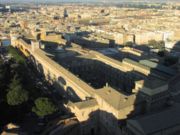
تقع روما في وسط البلاد على نهر التيبر، ليس بعيدا عن البحر الأبيض المتوسط. يبلغ معدل ارتفاعها عن سطح البحر حوالي 37 متر. تقع سلسلة جبال الأبروزي في شرق المدينة، في الشمال الشرقي تقع جبال سابينه وفي الجنوب تقع جبال الألبان. المدينة تقع في حوض التيبر، الذي يمر به كل من نهر التيبر ونهر أنينه متوحدين قبل دخولهم روما. بالنسبة لخطوط الطول والعرض فإن روما تقع على 41.53 درجة على خط الطول و12.29 درجة على خط الشرق. تدعى المنطقة الريفية التي تحوي روما بكامبانيا رومانا أو بشكل مختصر "كامبانيا". تحد مقاطعة روما من الشمال كل من مقاطعة فيتيربو ومقاطعة رييتي، من الشرق مقاطعة لاكويلا في ولاية أبروزي، من الجنوب مقاطعة فروسينونه ومقاطعة لاتينا.
المناخ
يتأثر مناخ روما بموقع المدينة القريب من البحر المتوسط. معدل درجة الحرارة على مدار العام تبلغ 15.5 درجة مئوية، بينما يبلغ معدل هطول الأمطار 880 ميلميتر. شهور يوليو وأغسطس هم أكثر شهور السنة حرارة مع معدل درجة حرارة يراوح 24.5 و 24.7 درجة مئوية. كما يعد هذان الشهران أكثر شهور السنة جفافا بنسبة كمية هطول الأمطار: ما بين 14 و22 ميليمتر. الأشهر أكتوبر إلى ديسمبر هي أكثر شهور السنة بنسبة هطول الأمطار حيث يبلغ المعدل ما بين 106 إلى 128 ميليمتر. أبرد الشهور هو شهر يناير بمعدل درجة حرارة يبلغ 6.9 درجة مئوية.
| أخفمتوسطات الطقس لRome, Italy | |||||||||||||
|---|---|---|---|---|---|---|---|---|---|---|---|---|---|
| شهر | يناير | فبراير | مارس | أبريل | مايو | يونيو | يوليو | أغسطس | سبتمبر | اكتوبر | نوفمبر | ديسمبر | السنة |
| متوسط العظمى °ف (°م) | 55 (12) | 56 (13) | 59 (15) | 63 (17) | 71 (21) | 77 (25) | 83 (28) | 83 (28) | 79 (26) | 71 (21) | 62 (16) | 57 (13) | 68 (20) |
| متوسط الصغرى °ف (°م) | 39 (3) | 40 (4) | 43 (6) | 47 (8) | 54 (12) | 61 (16) | 66 (18) | 67 (19) | 62 (16) | 56 (13) | 46 (7) | 42 (5) | 52 (11) |
| هطول الأمطار بوصة (cm) | 3.2 (8) | 2.8 (7) | 2.7 (6) | 2.0 (6) | 2.0 (5) | 1.3 (3) | 0.6 (1) | 1.0 (2) | 2.7 (6) | 4.5 (11) | 4.4 (11) | 3.8 (9) | 31٫6 (80) |
| المصدر: Weatherbase[23] 2007 | |||||||||||||
التقسيم السياسي
تنقسم روما إلى 19 بلدية و155 منطقة. البلديات يشكلون ضواحي المدينة. تم إدخال تقسيم البلديات ال 19 فقط منذ التسعينات من القرن السابق. كانوا في السابق 20 بلدية، ولكن تم فصل بلدية فيوميشينو عن المدينة لتصبح مدينة مستقلة إداريا. ضواحي روما مرقمة بالأرقام الرومانية للدلالة على تاريخ روما العريق:
- الشمال-الشرق (Area Nord-Est ): بلديات I, III, V, XVII
- الشمال-الغرب (Area Nord-Ovest) : بلديات II, IV, XVI, XVIII, XIX, XX
- الجنوب-الغرب (Area Sud-Ovest ):بلديات XII, XIII, XV
- الجنوب-الشرق (Area Sud-Est): بلديات VI, VII, VIII, IX, X, XI
عمدة روما هو والتر فيلتروني الذي تم انتخابه للمرة الثانية في 28 مايو 2006 بنسية 61% من الأصوات. [1]
المدينة الحديثة
تقع روما على ضفتي نهر التيبر في وسط إيطاليا، 16كم شرقي البحر التيراني. وتقع المدينة على 20 تلاً، وتمتد ضواحيها إلى المناطق السهلية. ويشمل موقعها التلال السبعة التي بنيت عليها روما، وهي تلال أفنتاين، كاليان، وكابتولين وإسكولين، وبالاتين، وكويرينال، وفيمينال. وتنتشر الآثار القديمة فوق تلك التلال بالإضافة إلى وجود الحدائق والأسواق الحديثة. ويوجد قصر الرئيس الإيطالي والبنايات الحكومية في كويرينال، وهي أعلى أحياء المدينة.
تنتشر الطرق الرومانية القديمة في كابتولين، مركز الحياة الرومانية، كما يوجد متحف فني مشهور، وبناية مجلس المدينة، وميدان صممه مهندس عصر النهضة مايكل أنجلو.
يوجد في وسط روما ميدان كولونا الذي يعد من أكثر مناطق المدينة نشاطًا؛ فتكثر فيه المصارف والفنادق، والمحلات التجارية الفخمة، والمكاتب والمطاعم، والمسارح. الشارع الرئيسي في المدينة هو شارع فيادل كورسو ويمتد 1,6كم في ميدان كولونا، ويربط بين عدة ميادين أخرى في الشمال والجنوب. واستعمل الشارع في العصور الوسطى ميدانًا لسباق الخيول.
مدينة الفاتيكان هي المركز الإداري والروحي للكنيسة الرومانية الكاثوليكية، وتقع في شمال غربي روما. وهي أصغر دولة مستقلة في العالم، ومساحتها حوالي 43,99 هكتارًا، أي ما يعادل 0,4كم². انظر: الفاتيكان، مدينة.
وتُعد مدينة روما من المراكز الفنية المهمة في العالم؛ فيكثر فيها الممثلون، والموسيقيون والرسامون، والنحاتون، والكُتّاب.
المتنزهات
تكثر الحدائق العامة في روما. وتقع هذه الحدائق ضمن ملكيات خاصة كانت لعائلات ثرية، ومنها حديقة بورنيس، التي فتحت للجمهور عام 1902م. ويوجد فيها، بالإضافة إلى المناظر الطبيعية الشهيرة، حديقة للحيوانات. ويزور كثير من السياح فيلا أدا، التي كانت مقر ملوك إيطاليا. ومن الحدائق المهمَّة غلوري وسيارا.
الموسيقى والمسرح
يوجد في روما أقدم أكاديمية موسيقية في العالم. وتحتوي الأكاديمية في القديسة سيسيليا على إحدى الفرق الموسيقية الرائدة. يحب أهل روما الأوبرا، وتُعرض الأوبرا في موسمين: تُعرض الحفلات في بيت الأوبرا من يناير إلى يونيو، وتُعرض الأوبرا من يوليو إلى أغسطس في الحمامات في كاراكالا، وكان المكان يشغل حمامات عامة أيام روما القديمة. وتُعرض في المسارح فنون محلية وأجنبية.
المتاحف وصالات العرض
يأتي السياح إلى روما لمشاهدة المجموعات الفنية النفيسة، فكثير من الرسومات والتماثيل معروضة في قصر الفاتيكان، الذي يحتوي على لوحات فنية فريدة لفنانين مشهورين مثل: ليوناردو دافينشي ومايكل أنجلو ورفائيل.تُعرض أقدم مجموعة فنية في متحف كابتولين في روما، الذي يحتوي على تماثيل رومانية قديمة. ويوجد في المتحف الوطني مجموعة فنية من وسط إيطاليا، يعود تاريخها إلى ما قبل التاريخ الروماني. ويحتوي المتحف الوطني الروماني على الكثير من التماثيل الرومانية والإغريقية وغيرها من آثار الحضارات القديمة. ويوجد في صالة العرض الوطنية للفن الحديث عدد من اللوحات الفريدة التي أنتجت في القرنين التاسع عشر والعشرين الميلاديين.
الكنائس والقصور والنوافير
تُعد كنيسة القديس بطرس في مدينة الفاتيكان أكبر كنيسة في أوروبا. وهي مثال لفن العمارة في عصر النهضة. اشترك مايكل أنجلو في تصميم الكنيسة في القرن السادس عشر الميلادي. انظر: القديس بطرس، كنيسة. كما يوجد في روما كنائس أخرى تعود للعصور القديمة.
وقصر البندقية من أشهر القصور الرومانية، بُني في القرن الخامس عشر الميلادي. واستقر الطاغية الإيطالي بنيتو موسوليني في القصر خلال العشرينيات والثلاثينيات من القرن العشرين الميلادي. ويستخدم القصر حالياً متحفًا. ويستعمل قصر ماداما مركزًا للبرلمان الإيطالي منذ 1871م. ويسكن الرئيس الإيطالي في قصر الكويرينال الذي كان مقرًا للبابا حتى عام 1870م، ومقرًا لملوك إيطاليا من 1871م حتى 1946م.
يوجد في روما عدد من النوافير المائية، والتي تُعد من الأعمال الفنية الشهيرة. وانتهى العمل في نافورة تريفي عام 1762م. وهي مشهورة عند الأجانب، وتقول الأسطورة إن من يرمي نقودًا في النافورة، سيعود يومًا ما إلى المدينة.
جامعة روما أنشئت سنة 1303م وهي أكبر الجامعات في إيطاليا ويدرس فيها نحو 180,000 طالب وطالبة.
التعليم
أنشئت جامعة روما عام 1303م، وهي أكبر جامعة في إيطاليا. انظر: روما، جامعة. تُدير جماعات دينية من الكنيسة الرومانية الكاثولكية عدداً من المعاهد في الفاتيكان، يتعلم فيها طلاب من دول متعددة ليصبحوا رهباناً. وتخرَّج في معهد شمالي أمريكا، على سبيل المثال، حوالي 1,800 راهب أمريكي منذ نشأة المعهد عام 1859م.
يُلزم القانون الأطفال بالالتحاق بالمدارس من عمر 6- 14 سنة. بعد ذلك، يختار الطلاب الالتحاق بمرحلة تعليمية أعلى في المدارس الثانوية أو المدارس الفنية. يدفع الطلاب مبالغ محدودة للالتحاق بالمدارس الثانوية. كما يوجد عدد من المدارس المستقلة التي تديرها هيئات دينية.
أُسِّست مكتبة الفاتيكان في القرن الخامس عشر الميلادي، وهي من المكتبات المهمة في العالم. انظر: مكتبة الفاتيكان. ويوجد في روما تسع مكتبات عامة تحتوي على حوالي ثلاثة ملايين كتاب. وتوجد مكتبات أخرى تعمل بنظام الرومانية الكاثوليكية.
دار الرياضة سبورتس بالاس بنيت لإقامة الألعاب الأوليمبية الصيفية فيها سنة 1960م. وتقع هذه الدار في الضواحي الجنوبية الغربية للمدينة.
الرياضة
كرة القدم أكثر النشاطات الرياضية شعبية، ويحضر المباريات أعداد كبيرة من المتفرجين في الإستاد الأوليمبي. يجري عرض للخيول في ميدان سينا وكابانيلي. كما يهتم أهل روما بنشاطات أخرى مثل كرة السلة والملاكمة والتنس.
الاقتصاد
روما مدينة غير صناعية، ويعمل حوالي خُمس العمال في الصناعة. ويعمل معظمهم في وظائف غير صناعية كالتجارة والسياحة والمطاعم والحكومة. ومن منتجات روما الصناعية الملابس والمنسوجات والأغذية ومواد أخرى. وتقع معظم المصانع في الجزء الشمالي الغربي من المدينة.
ويشكل إنتاج الأفلام السينمائية جزءًا مهمًا من اقتصاد المدينة؛ فهي من المدن المهمة عالمياً في إنتاج الأفلام. تُعد روما ملتقى المواصلات في إيطاليا، وتربط الطرق والسكك الحديدية روما بجميع أجزاء البلاد. يستخدم السكان في تنقلاتهم القطارات والحافلات والترام والسيارات. ومنذ عام 1973م، مُنعت السيارات الخاصة من دخول بعض أجزاء المدينة لتخفيف الازدحام والتلوث.
يُنشر في روما عدد من الصُحف اليومية أهمها مسيجارو وتِمْبو وربَبْليكا. وتصدر الفاتيكان صحيفة شبه رسمية باسم الكنيسة الرومانية الكاثوليكية، وتدعى أوفسيرفاتوري رومانو. كما توجد صحف أخرى تهتم بالرياضة والسياسة. وروما أيضًا مركز لمحطة الإذاعة والتلفاز.
الحكومة
يحكم روما مجلس المدينة المكوّن من 80 عضوًا، يُنتخبون كل أربع سنوات. وينتخب المجلس أحد أعضائه ليشغل منصب المحافظ لمدة أربع سنوات. كما ينتخب 18 من أعضائه للمجلس التنفيذي في المدينة لمدة أربع سنوات. المحافظ هو رئيس المجلس والرئيس الإداري للمدينة. يُدير مجلس المدينة 15 قسمًا تمثل: الصحة والتسويق والأعمال العامة والنقل.
المدينة القديمة
الكولوسيوم مدرج ضخم للاحتفالات الرومانية.
الساحة العامة
كان مركز الحياة الرومانية في ساحة مفتوحة تسمى فورَمْ، حيث تعقد فيها الاجتماعات العامة. وكانت الساحة مركزاً للحكومة الرومانية. ويوجد فيها العديد من التماثيل، والبنايات الحكومية، والآثار القديمة.
معظم شوارع روما القديمة ضيقة ومزدحمة، والقليل منها واسع وجميل ومحاط بالأقواس والبنايات الرخامية. أهم الطرق شارع فياساكرا الذي يمر في الساحة الرومانية. وقد دُفنَ كثير من الأباطرة والقواد العائدين من الحروب في تلك الساحة. انظر: الفورم الروماني.
الكولوسيوم
أنشئ الكولوسيوم عام 80م، وهو من معالم روما الرئيسية. وهو مسرح كبير كان يشاهد فيه الأبطال يُقاتلون الحيوانات المفترسة. وشاهد الرومان مقتل النَّصارى أثناء مصارعتهم الأسود. انظر: الكولوسيوم.
حمامات كاراكالا حمامات عامة يعود تاريخها إلى القرن الثالث الميلادي، وتقام حفلات الأوبرا في هذه الأطلال التاريخية في الصيف.
الحمامات
اقتصرت ملكية الحمامات على الأغنياء فقط، ولكن يوجد في المدينة كثير من الحمامات العامة. وكانت تستخدم أماكن للاجتماعات العامة في عهد الأباطرة. وهي على شكل بركة سباحة مربعة الشكل وكبيرة الحجم، ومحاطة بالحدائق والأعمدة الرخامية والمكتبات. وكانت فيها حمامات ساخنة، وباردة، وبخارية، وأماكن للتدليك. ومن أهم آثار الحمامات تلك الموجودة في كاراكالا وديوكلشيان. ويعود تاريخ حمامات كاراكالا إلى القرن الثالث الميلادي، وهي مزينة بالرخام والتماثيل، وتُعرض فيها حالياً الأوبرا صيفًا. وأنشئت حمامات ديوكليشيان في القرن الرابع الميلادي. وهي أكبر الحمامات الرومانية، فكانت تخدم حوالي 3,000 شخص في وقت واحد. تهدّمت معظم الحمامات، ولكن يمكن مشاهدة بعض الحجرات فيها.
سراديب الموتى
 مقالة مفصلة: دياميس روما
مقالة مفصلة: دياميس روما
دياميس روما هي سراديب أو ممرات تحت الأرض وحجرات استُعملت مقابر وكنائس. حفر النَّصارى الأوائل تلك السراديب من القرن الثاني إلى أوائل القرن الخامس الميلادي؛ ليختبئوا فيها أيام الإعدامات. تزين الرسومات والشعارات النَّصرانيَّة جدرانها وأسقفها. وأهم السراديب هي الموجودة في سان كاليستو وسان سباستيانو وسانت آگنس.
قوس قسطنطين بني لتخليد أحد الانتصارات الحربية.
آثار أخرى
يعدُّ البانثيون من أفضل الآثار الرومانية التي مازالت قائمة، بناه الرومان هيكلاً لتكريم آلهتهم. انظر: البانثيون. وشيد قوس قسطنطين الثلاثي عام 315م، ومازال قائماً، وهو عبارة عن ثلاثة أقواس متصلة الجوانب، ومزينة بالتماثيل.
توجد بقايا البيت الذهبي في الحديقة العامة، وهو مزين بالرسومات، وكان مقراً للإمبراطور نيرون. وشيد برج ماركوس أوريليوس في القرن الثاني الميلادي تكريماً للانتصارات الرومانية في الحروب. ونُحت بداخله درج يقود إلى تمثال القديس بول الذي وضع في هذا المكان عام 1589م.
أفق المدينة
العمارة
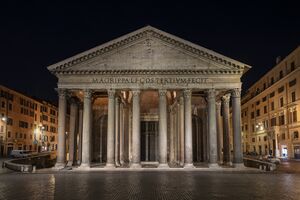
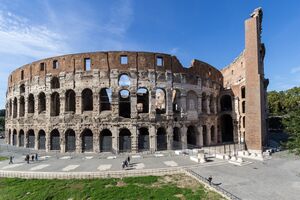
Rome's architecture over the centuries has greatly developed, especially from the Classical and Imperial Roman styles to modern fascist architecture. Rome was for a period one of the world's main epicentres of classical architecture, developing new forms such as the arch, the dome and the vault.[25] The Romanesque style in the 11th, 12th, and 13th centuries was also widely used in Roman architecture, and later the city became one of the main centres of Renaissance, Baroque and neoclassical architecture.[25]
روما القديمة
One of the symbols of Rome is the Colosseum (70–80 AD), the largest amphitheatre ever built in the Roman Empire. Originally capable of seating 60,000 spectators, it was used for gladiatorial combat. Important monuments and sites of ancient Rome include the Roman Forum, the Domus Aurea, the Pantheon, Trajan's Column, Trajan's Market, the Catacombs, the Circus Maximus, the Baths of Caracalla, Castel Sant'Angelo, the Mausoleum of Augustus, the Ara Pacis, the Arch of Constantine, the Pyramid of Cestius, and the Bocca della Verità.
القروسطية
The medieval popular quarters of the city, situated mainly around the Capitol, were largely demolished between the end of the 19th century and the fascist period, but many notable buildings still remain. Basilicas dating from Christian antiquity include Saint Mary Major and Saint Paul outside the Walls (the latter largely rebuilt in the 19th century), both housing precious fourth century AD mosaics. Notable later medieval mosaics and frescoes can be also found in the churches of Santa Maria in Trastevere, Santi Quattro Coronati, and Santa Prassede. Secular buildings include a number of towers, the largest being the Torre delle Milizie and the Torre dei Conti, both next to the Roman Forum, and the huge outdoor stairway leading up to the basilica of Santa Maria in Aracoeli.
النهضة والباروك
Rome was a major world centre of the Renaissance, second only to Florence, and was profoundly affected by the movement. Among others, a masterpiece of Renaissance architecture in Rome is the Piazza del Campidoglio by Michelangelo. During this period, the great aristocratic families of Rome used to build opulent dwellings as the Palazzo del Quirinale (now seat of the President of the Italian Republic), the Palazzo Venezia, the Palazzo Farnese, the Palazzo Barberini, the Palazzo Chigi (now seat of the Italian Prime Minister), the Palazzo Spada, the Palazzo della Cancelleria, and the Villa Farnesina.
Many of the famous city's squares – some huge, majestic and often adorned with obelisks, some small and picturesque – took their present shape during the Renaissance and Baroque periods. The principal ones are Piazza Navona, the Spanish Steps, Campo de' Fiori, Piazza Venezia, Piazza Farnese, Piazza della Rotonda and Piazza della Minerva. One of the most emblematic examples of Baroque art is the Trevi Fountain by Nicola Salvi. Other notable 17th-century Baroque palaces are the Palazzo Madama, now the seat of the Italian Senate, and the Palazzo Montecitorio, now the seat of the Chamber of Deputies of Italy.
النيوكلاسيكية
In 1870, Rome became the capital city of the new Kingdom of Italy. During this time, neoclassicism, a building style influenced by the architecture of antiquity, became the predominant influence in Roman architecture. During this period, many great palaces in neoclassical styles were built to host ministries, embassies, and other government agencies. One of the best-known symbols of Roman neoclassicism is the Monument to Vittorio Emanuele II or "Altar of the Fatherland", where the Grave of the Unknown Soldier, who represents the 650,000 Italian soldiers who died in World War I, is located.
العمارة الفاشية

The Fascist regime that ruled in Italy between 1922 and 1943 had its showcase in Rome. Mussolini ordered the construction of new roads and piazzas, resulting in the destruction of older roads, houses, churches and palaces erected during papal rule. The main activities during his government were: the "isolation" of the Capitoline Hill; Via dei Monti, later renamed Via del'Impero, and finally Via dei Fori Imperiali; Via del Mare, later renamed Via del Teatro di Marcello; the "isolation" of the Mausoleum of Augustus, with the erection of Piazza Augusto Imperatore; and Via della Conciliazione.
Architecturally, Italian Fascism favoured the most modern movements, such as Rationalism. Parallel to this, in the 1920s another style emerged, named "Stile Novecento", characterised by its links with ancient Roman architecture. Two important complexes in the latter style are the Foro Mussolini, now Foro Italico, by Enrico Del Debbio, and the Città universitaria ("University city"), by Marcello Piacentini, also author of the controversial destruction of part of the Borgo rione to open Via della Conciliazione.
The most important Fascist site in Rome is the EUR district, designed in 1938 by Piacentini. This new quarter emerged as a compromise between Rationalist and Novecento architects, the former being led by Giuseppe Pagano. The EUR was originally conceived for the 1942 world exhibition, and was called "E.42" ("Esposizione 42"). The most representative buildings of EUR are the Palazzo della Civiltà Italiana (1938–1943), and the Palazzo dei Congressi, examples of the Rationalist style. The world exhibition never took place, because Italy entered the Second World War in 1940, and the buildings were partly destroyed in 1943 in fighting between the Italian and German armies and later abandoned. The quarter was restored in the 1950s when the Roman authorities found that they already had the seed of an off-centre business district of the type that other capitals were still planning (London Docklands and La Défense in Paris). Also, the Palazzo della Farnesina, the current seat of the Italian Ministry of Foreign Affairs, was designed in 1935 in pure Fascist style.
المنتزهات والحدائق
Public parks and nature reserves cover a large area in Rome, and the city has one of the largest areas of green space among European capitals.[26] The most notable part of this green space is represented by the large number of villas and landscaped gardens created by the Italian aristocracy. While most of the parks surrounding the villas were destroyed during the building boom of the late 19th century, some of them remain. The most notable of these are the Villa Borghese, Villa Ada, and Villa Doria Pamphili. Villa Doria Pamphili is west of the Gianicolo hill, comprising some 1.8 km2 (0.7 sq mi). The Villa Sciarra is on the hill, with playgrounds for children and shaded walking areas. In the nearby area of Trastevere, the Orto Botanico (Botanical Garden) is a cool and shady green space. The old Roman hippodrome (Circus Maximus) is another large green space: it has few trees but is overlooked by the Palatine and the Rose Garden ('roseto comunale'). Nearby is the lush Villa Celimontana, close to the gardens surrounding the Baths of Caracalla. The Villa Borghese garden is the best known large green space in Rome, with famous art galleries among its shaded walks. Overlooking Piazza del Popolo and the Spanish Steps are the gardens of Pincio and Villa Medici. There is also a notable pine wood at Castelfusano, near Ostia. Rome also has a number of regional parks of much more recent origin, including the Pineto Regional Park and the Appian Way Regional Park. There are also nature reserves at Marcigliana and at Tenuta di Castelporziano.
النوافير ومجاري المياه المرفوعة
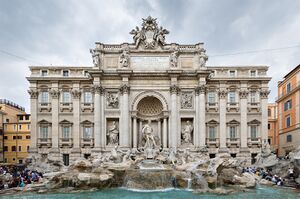
Rome is a city known for its numerous fountains, built-in all different styles, from Classical and Medieval, to Baroque and Neoclassical. The city has had fountains for more than two thousand years, and they have provided drinking water and decorated the piazzas of Rome. During the Roman Empire, in 98 AD, according to Sextus Julius Frontinus, the Roman consul who was named curator aquarum or guardian of the water of the city, Rome had nine aqueducts which fed 39 monumental fountains and 591 public basins, not counting the water supplied to the Imperial household, baths, and owners of private villas. Each of the major fountains was connected to two different aqueducts, in case one was shut down for service.[27]
During the 17th and 18th century, the Roman popes reconstructed other degraded Roman aqueducts and built new display fountains to mark their termini, launching the golden age of the Roman fountain. The fountains of Rome, like the paintings of Rubens, were expressions of the new style of Baroque art. In these fountains, sculpture became the principal element, and the water was used simply to animate and decorate the sculptures. They, like baroque gardens, were "a visual representation of confidence and power".[28]
التماثيل
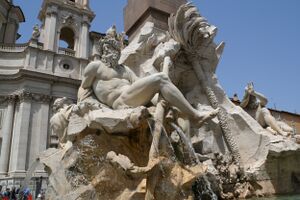
Rome is well known for its statues but, in particular, the talking statues of Rome. These are usually ancient statues which have become popular soapboxes for political and social discussion, and places for people to (often satirically) voice their opinions. There are two main talking statues: the Pasquino and the Marforio, yet there are four other noted ones: il Babuino, Madama Lucrezia, il Facchino and Abbot Luigi. Most of these statues are ancient Roman or classical, and most of them also depict mythical gods, ancient people or legendary figures; il Pasquino represents Menelaus, Abbot Luigi is an unknown Roman magistrate, il Babuino is supposed to be Silenus, Marforio represents Oceanus, Madama Lucrezia is a bust of Isis, and il Facchino is the only non-Roman statue, created in 1580, and not representing anyone in particular. They are often, due to their status, covered with placards or graffiti expressing political ideas and points of view. Other statues in the city, which are not related to the talking statues, include those of the Ponte Sant'Angelo, or several monuments scattered across the city, such as that to Giordano Bruno in the Campo de'Fiori.
المسلات والأعمدة
The city hosts eight ancient Egyptian and five ancient Roman obelisks, together with a number of more modern obelisks; there was also formerly (until 2005) an ancient Ethiopian obelisk in Rome.[29] The city contains some of obelisks in piazzas, such as in Piazza Navona, St Peter's Square, Piazza Montecitorio, and Piazza del Popolo, and others in villas, thermae parks and gardens, such as in Villa Celimontana, the Baths of Diocletian, and the Pincian Hill. Moreover, the centre of Rome hosts also Trajan's and Antonine Column, two ancient Roman columns with spiral relief. The Column of Marcus Aurelius is located in Piazza Colonna and it was built around 180 AD by Commodus in memory of his parents. The Column of Marcus Aurelius was inspired by Trajan's Column at Trajan's Forum, which is part of the Imperial Fora.[30]
الجسور

The city of Rome contains numerous famous bridges which cross the Tiber. The only bridge to remain unaltered until today from the classical age is Ponte dei Quattro Capi, which connects the Isola Tiberina with the left bank. The other surviving – albeit modified – ancient Roman bridges crossing the Tiber are Ponte Cestio, Ponte Sant'Angelo and Ponte Milvio. Considering Ponte Nomentano, also built during ancient Rome, which crosses the Aniene, currently there are five ancient Roman bridges still remaining in the city.[31] Other noteworthy bridges are Ponte Sisto, the first bridge built in the Renaissance above Roman foundations; Ponte Rotto, actually the only remaining arch of the ancient Pons Aemilius, collapsed during the flood of 1598 and demolished at the end of the 19th century; and Ponte Vittorio Emanuele II, a modern bridge connecting Corso Vittorio Emanuele and Borgo. Most of the city's public bridges were built in Classical or Renaissance style, but also in Baroque, Neoclassical and Modern styles. According to the Encyclopædia Britannica, the finest ancient bridge remaining in Rome is the Ponte Sant'Angelo, which was completed in 135 AD, and was decorated with ten statues of the angels, designed by Bernini in 1688.[32]
الدياميس
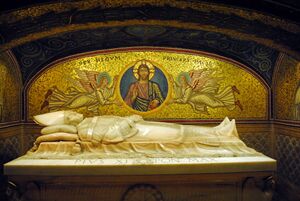
Rome has an extensive amount of ancient catacombs, or underground burial places under or near the city, of which there are at least forty, some discovered only in recent decades. Though most famous for Christian burials, they include pagan and Jewish burials, either in separate catacombs or mixed together. The first large-scale catacombs were excavated from the 2nd century onwards. Originally they were carved through tuff, a soft volcanic rock, outside the boundaries of the city, because Roman law forbade burial places within city limits. Currently, maintenance of the catacombs is in the hands of the Papacy which has invested in the Salesians of Don Bosco the supervision of the Catacombs of St. Callixtus on the outskirts of Rome.
الاقتصاد
As the capital of Italy, Rome hosts all the principal institutions of the nation, including the Presidency of the Republic, the government (and its single Ministeri), the Parliament, the main judicial Courts, and the diplomatic representatives of all the countries for the states of Italy and Vatican City. Many international institutions are located in Rome, notably cultural and scientific ones, such as the American Institute, the British School, the French Academy, the Scandinavian Institutes, and the German Archaeological Institute. There are also specialised agencies of the United Nations, such as the Food and Agriculture Organization (FAO). Rome also hosts major international and worldwide political and cultural organisations, such as the International Fund for Agricultural Development (IFAD), World Food Programme (WFP), the NATO Defence College, and the International Centre for the Study of the Preservation and Restoration of Cultural Property (ICCROM).
According to the GaWC study of world cities, Rome is a "Beta +" city.[33] The city was ranked in 2014 as 32nd in the Global Cities Index, the highest in Italy.[34] With a 2005 GDP of €94.376 billion (US$121.5 billion),[35][needs update] the city produces 6.7% of the national GDP (more than any other single city in Italy), and its unemployment rate, lowered from 11.1% to 6.5% between 2001 and 2005, is now one of the lowest rates of all the European Union capital cities.[35] Rome's economy grows at around 4.4% annually and continues to grow at a higher rate in comparison to any other city in the rest of the country.[35] This means that were Rome a country, it would be the world's 52nd richest country by GDP, near to the size to that of Egypt. Rome also had a 2003 GDP per capita of €29,153 (US$37,412), which was second in Italy (after Milan), and is more than 134.1% of the EU average GDP per capita.[36][needs update] Rome, on the whole, has the highest total earnings in Italy, reaching €47,076,890,463 in 2008,[37][needs update] yet, in terms of average workers' incomes, the city places itself 9th in Italy, with €24,509.[37] On a global level, Rome's workers receive the 30th highest wages in 2009, coming three places higher than in 2008, in which the city ranked 33rd.[38][needs update] The Rome area had a GDP amounting to $167.8 billion, and $38,765 per capita.[39]
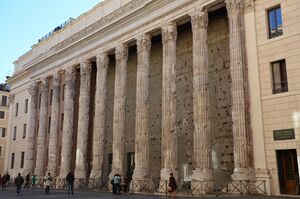
Although the economy of Rome is characterised by the absence of heavy industry, and it is largely dominated by services, high-technology companies (IT, aerospace, defence, telecommunications), research, construction and commercial activities (especially banking), and the huge development of tourism are very dynamic and extremely important to its economy. Rome's international airport, Fiumicino, is the largest in Italy, and the city hosts the head offices of the vast majority of the major Italian companies, as well as the headquarters of three of the world's 100 largest companies: Enel, Eni, and Telecom Italia.[40]
Universities, national radio and television and the movie industry in Rome are also important parts of the economy: Rome is also the hub of the Italian film industry, thanks to the Cinecittà studios, working since the 1930s. The city is also a centre for banking and insurance as well as electronics, energy, transport, and aerospace industries. Numerous international companies and agencies headquarters, government ministries, conference centres, sports venues, and museums are located in Rome's principal business districts: the Esposizione Universale Roma (EUR); the Torrino (further south from the EUR); the Magliana; the Parco de' Medici-Laurentina and the so-called Tiburtina-valley along the ancient Via Tiburtina.
التعليم
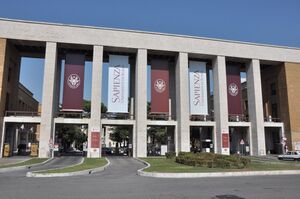
Rome is a nationwide and major international centre for higher education, containing numerous academies, colleges and universities. It boasts a large variety of academies and colleges, and has always been a major worldwide intellectual and educational centre, especially during Ancient Rome and the Renaissance, along with Florence.[41] According to the City Brands Index, Rome is considered the world's second most historically, educationally and culturally interesting and beautiful city.[42]
Rome has many universities and colleges. Its first university, La Sapienza (founded in 1303), is one of the largest in the world, with more than 140,000 students attending; in 2005 it ranked as Europe's 33rd best university[43] and in 2013 the Sapienza University of Rome ranked as the 62nd in the world and the top in Italy in its World University Rankings.[44] and has been ranked among Europe's 50 and the world's 150 best colleges.[45] In order to decrease the overcrowding of La Sapienza, two new public universities were founded during the last decades: Tor Vergata in 1982, and Roma Tre in 1992. Rome hosts also the LUISS School of Government,[46] Italy's most important graduate university in the areas of international affairs and European studies as well as LUISS Business School, Italy's most important business school. Rome ISIA was founded in 1973 by Giulio Carlo Argan and is Italy's oldest institution in the field of industrial design.
Rome contains many pontifical universities and other institutes, including the British School at Rome, the French School in Rome, the Pontifical Gregorian University (the oldest Jesuit university in the world, founded in 1551), Istituto Europeo di Design, the Scuola Lorenzo de' Medici, the Link Campus of Malta, and the Università Campus Bio-Medico. Rome is also the location of two American Universities; The American University of Rome[47] and John Cabot University as well as St. John's University branch campus, John Felice Rome Center, a campus of Loyola University Chicago and Temple University Rome, a campus of Temple University.[48] The Roman Colleges are several seminaries for students from foreign countries studying for the priesthood at the Pontifical Universities.[49] Examples include the Venerable English College, the Pontifical North American College, the Scots College, and the Pontifical Croatian College of St. Jerome.
Rome's major libraries include: the Biblioteca Angelica, opened in 1604, making it Italy's first public library; the Biblioteca Vallicelliana, established in 1565; the Biblioteca Casanatense, opened in 1701; the National Central Library, one of the two national libraries in Italy, which contains 4,126,002 volumes; The Biblioteca del Ministero degli Affari Esteri, specialised in diplomacy, foreign affairs and modern history; the Biblioteca dell'Istituto dell'Enciclopedia Italiana; the Biblioteca Don Bosco, one of the largest and most modern of all Salesian libraries; the Biblioteca e Museo teatrale del Burcardo, a museum-library specialised in history of drama and theatre; the Biblioteca della Società Geografica Italiana, which is based in the Villa Celimontana and is the most important geographical library in Italy, and one of Europe's most important;[50] and the Vatican Library, one of the oldest and most important libraries in the world, which was formally established in 1475, though in fact much older and has 75,000 codices, as well as 1.1 million printed books, which include some 8,500 incunabula. There are also many specialist libraries attached to various foreign cultural institutes in Rome, among them that of the American Academy in Rome, the French Academy in Rome and the Bibliotheca Hertziana – Max Planck Institute of Art History, a German library, often noted for excellence in the arts and sciences.[51]
الثقافة
الترفيه والفنون الأدائية

Rome is an important centre for music, and it has an intense musical scene, including several prestigious music conservatories and theatres. It hosts the Accademia Nazionale di Santa Cecilia (founded in 1585), for which new concert halls have been built in the new Parco della Musica, one of the largest musical venues in the world. Rome also has an opera house, the Teatro dell'Opera di Roma, as well as several minor musical institutions. The city also played host to the Eurovision Song Contest in 1991 and the MTV Europe Music Awards in 2004.
Rome has also had a major impact on music history. The Roman School was a group of composers of predominantly church music, which were active in the city during the 16th and 17th centuries, therefore spanning the late Renaissance and early Baroque eras. The term also refers to the music they produced. Many of the composers had a direct connection to the Vatican and the papal chapel, though they worked at several churches; stylistically they are often contrasted with the Venetian School of composers, a concurrent movement which was much more progressive. By far the most famous composer of the Roman School is Giovanni Pierluigi da Palestrina, whose name has been associated for four hundred years with smooth, clear, polyphonic perfection. However, there were other composers working in Rome, and in a variety of styles and forms.
Between 1960 and 1970 Rome was considered to be as a "new Hollywood" because of the many actors and directors who worked there; Via Vittorio Veneto had transformed into a glamour place where you could meet famous people.[52]
السياحة
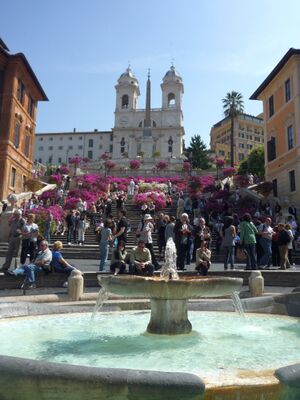
Rome today is one of the most important tourist destinations of the world, due to the incalculable immensity of its archaeological and artistic treasures, as well as for the charm of its unique traditions, the beauty of its panoramic views, and the majesty of its magnificent "villas" (parks). Among the most significant resources are the many museums – Musei Capitolini, the Vatican Museums and the Galleria Borghese and others dedicated to modern and contemporary art – aqueducts, fountains, churches, palaces, historical buildings, the monuments and ruins of the Roman Forum, and the Catacombs. Rome is the third most visited city in the EU, after London and Paris, and receives an average of 7–10 million tourists a year, which sometimes doubles on holy years. The Colosseum (4 million tourists) and the Vatican Museums (4.2 million tourists) are the 39th and 37th (respectively) most visited places in the world, according to a recent study.[53]
Rome is a major archaeological hub, and one of the world's main centres of archaeological research. There are numerous cultural and research institutes located in the city, such as the American Academy in Rome,[54] and The Swedish Institute at Rome.[55] Rome contains numerous ancient sites, including the Forum Romanum, Trajan's Market, Trajan's Forum,[56] the Colosseum, and the Pantheon, to name but a few. The Colosseum, arguably one of Rome's most iconic archaeological sites, is regarded as a wonder of the world.[57][58]
Rome contains a vast and impressive collection of art, sculpture, fountains, mosaics, frescos, and paintings, from all different periods. Rome first became a major artistic centre during ancient Rome, with forms of important Roman art such as architecture, painting, sculpture and mosaic work. Metal-work, coin die and gem engraving, ivory carvings, figurine glass, pottery, and book illustrations are considered to be 'minor' forms of Roman artwork.[59] Rome later became a major centre of Renaissance art, since the popes spent vast sums of money for the constructions of grandiose basilicas, palaces, piazzas and public buildings in general. Rome became one of Europe's major centres of Renaissance artwork, second only to Florence, and able to compare to other major cities and cultural centres, such as Paris and Venice. The city was affected greatly by the baroque, and Rome became the home of numerous artists and architects, such as Bernini, Caravaggio, Carracci, Borromini and Cortona.[60] In the late 18th century and early 19th century, the city was one of the centres of the Grand Tour,[61] when wealthy, young English and other European aristocrats visited the city to learn about ancient Roman culture, art, philosophy, and architecture. Rome hosted a great number of neoclassical and rococo artists, such as Pannini and Bernardo Bellotto. Today, the city is a major artistic centre, with numerous art institutes[62] and museums.
Rome has a growing stock of contemporary and modern art and architecture. The National Gallery of Modern Art has works by Balla, Morandi, Pirandello, Carrà, De Chirico, De Pisis, Guttuso, Fontana, Burri, Mastroianni, Turcato, Kandisky, and Cézanne on permanent exhibition. 2010 saw the opening of Rome's newest arts foundation, a contemporary art and architecture gallery designed by acclaimed Iraqi architect Zaha Hadid. Known as MAXXI – National Museum of the 21st Century Arts it restores a dilapidated area with striking modern architecture. Maxxi[64] features a campus dedicated to culture, experimental research laboratories, international exchange and study and research. It is one of Rome's most ambitious modern architecture projects alongside Renzo Piano's Auditorium Parco della Musica[65] and Massimiliano Fuksas' Rome Convention Center, Centro Congressi Italia EUR, in the EUR district, due to open in 2016.[66] The convention centre features a huge translucent container inside which is suspended a steel and teflon structure resembling a cloud and which contains meeting rooms and an auditorium with two piazzas open to the neighbourhood on either side.
الموضة
Rome is also widely recognised as a world fashion capital. Although not as important as Milan, Rome is the fourth most important centre for fashion in the world, according to the 2009 Global Language Monitor after Milan, New York, and Paris, and beating London.[67]
Major luxury fashion houses and jewellery chains, such as Valentino, Bulgari, Fendi,[68] Laura Biagiotti, Brioni, and Renato Balestra, are headquartered or were founded in the city. Also, other major labels, such as Gucci, Chanel, Prada, Dolce & Gabbana, Armani, and Versace have luxury boutiques in Rome, primarily along its prestigious and upscale Via dei Condotti.
المطبخ

Rome's cuisine has evolved through centuries and periods of social, cultural, and political changes. Rome became a major gastronomical centre during the ancient age. Ancient Roman cuisine was highly influenced by Ancient Greek culture, and after, the empire's enormous expansion exposed Romans to many new, provincial culinary habits and cooking techniques.[69]
Later, during the Renaissance, Rome became well known as a centre of high-cuisine, since some of the best chefs of the time worked for the popes. An example of this was Bartolomeo Scappi, who was a chef working for Pius IV in the Vatican kitchen, and he acquired fame in 1570 when his cookbook Opera dell'arte del cucinare was published. In the book he lists approximately 1000 recipes of the Renaissance cuisine and describes cooking techniques and tools, giving the first known picture of a fork.[70]
The Testaccio, Rome's trade and slaughterhouse area, was often known as the "belly" or "slaughterhouse" of Rome, and was inhabited by butchers, or vaccinari.[71] The most common or ancient Roman cuisine included the "fifth quarter".[71] The old-fashioned coda alla vaccinara (oxtail cooked in the way of butchers)[71] is still one of the city's most popular meals and is part of most of Rome's restaurants' menus. Lamb is also a very popular part of Roman cuisine, and is often roasted with spices and herbs.[71]
In the modern age, the city developed its own peculiar cuisine, based on products of the nearby Campagna, as lamb and vegetables (globe artichokes are common).[72] In parallel, Roman Jews – present in the city since the 1st century BC – developed their own cuisine, the cucina giudaico-romanesca.
Examples of Roman dishes include saltimbocca alla romana – a veal cutlet, Roman-style, topped with raw ham and sage and simmered with white wine and butter; carciofi alla romana – artichokes Roman-style, outer leaves removed, stuffed with mint, garlic, breadcrumbs and braised; carciofi alla giudia – artichokes fried in olive oil, typical of Roman Jewish cooking, outer leaves removed, stuffed with mint, garlic, breadcrumbs and braised; spaghetti alla carbonara – spaghetti with bacon, eggs and pecorino; and gnocchi di semolino alla romana – semolina dumpling, Roman-style.[73]
السينما
Rome hosts the Cinecittà Studios,[75] the largest film and television production facility in continental Europe and the centre of the Italian cinema, where many of today's biggest box office hits are filmed. The 99-acre (40 ha) studio complex is 9.0 km (5.6 mi) from the centre of Rome and is part of one of the biggest production communities in the world, second only to Hollywood, with well over 5,000 professionals – from period costume makers to visual effects specialists. More than 3,000 productions have been made on its lot, from recent features like The Passion of the Christ, Gangs of New York, HBO's Rome, The Life Aquatic and Dino De Laurentiis' Decameron, to such cinema classics as Ben-Hur, Cleopatra, and the films of Federico Fellini.[بحاجة لمصدر]
Founded in 1937 by Benito Mussolini, the studios were bombed by the Western Allies during the Second World War. In the 1950s, Cinecittà was the filming location for several large American film productions, and subsequently became the studio most closely associated with Federico Fellini. Today, Cinecittà is the only studio in the world with pre-production, production, and full post-production facilities on one lot, allowing directors and producers to walk in with their script and "walkout" with a completed film.[بحاجة لمصدر]
اللغة
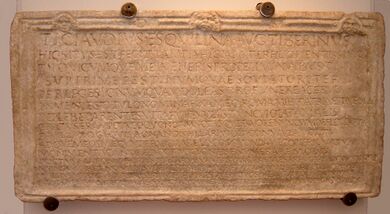
Although associated today only with Latin, ancient Rome was in fact multilingual. In the highest antiquity, Sabine tribes shared the area of what is today Rome with Latin tribes. The Sabine language was one of the Italic group of ancient Italian languages, along with Etruscan, which would have been the main language of the last three kings who ruled the city till the founding of the Republic in 509 BC. Urganilla, or Plautia Urgulanilla, wife of Emperor Claudius, is thought to have been a speaker of Etruscan many centuries after this date, according to Suetonius' entry on Claudius. However Latin, in various evolving forms, was the main language of classical Rome, but as the city had immigrants, slaves, residents, ambassadors from many parts of the world it was also multilingual. Many educated Romans also spoke Greek, and there was a large Greek, Syriac and Jewish population in parts of Rome from well before the Empire.
Latin evolved during the Middle Ages into a new language, the "volgare". The latter emerged as the confluence of various regional dialects, among which the Tuscan dialect predominated, but the population of Rome also developed its own dialect, the Romanesco. The Romanesco spoken during the Middle Ages was more like a southern Italian dialect, very close to the Neapolitan language in Campania. The influence of the Florentine culture during the renaissance, and above all, the immigration to Rome of many Florentines following the two Medici Popes (Leo X and Clement VII), caused a major shift in the dialect, which began to resemble more the Tuscan varieties. This remained largely confined to Rome until the 19th century, but then expanded to other zones of Lazio (Civitavecchia, Latina and others), from the beginning of the 20th century, thanks to the rising population of Rome and to improving transportation systems. As a consequence of education and media like radio and television, Romanesco became more similar to standard Italian but does not represent standard Italian. Dialectal literature in the traditional form of Romanesco includes the works of such authors as Giuseppe Gioachino Belli, Trilussa and Cesare Pascarella. It is worth remembering though that Romanesco was a "lingua vernacola" (vernacular language), meaning that for centuries, it did not have a written form but it was only spoken by the population.
Contemporary Romanesco is mainly represented by popular actors and actresses, such as Alberto Sordi, Aldo Fabrizi, Anna Magnani, Carlo Verdone, Enrico Montesano, Gigi Proietti and Nino Manfredi.
Rome's historic contribution to language in a worldwide sense is much more extensive, however. Through the process of Romanization, the peoples of Italy, Gallia, the Iberian Peninsula and Dacia developed languages which derive directly from Latin and were adopted in large areas of the world, all through cultural influence, colonisation and migration. Moreover, also modern English, because of the Norman Conquest, borrowed a large percentage of its vocabulary from the Latin language. The Roman or Latin alphabet is the most widely used writing system in the world used by the greatest number of languages.[77]
Rome has long hosted artistic communities, foreign resident communities and many foreign religious students or pilgrims and so has always been a multilingual city. Today because of mass tourism, many languages are used in servicing tourism, especially English which is widely known in tourist areas, and the city hosts large numbers of immigrants and so has many multilingual immigrant areas.
النقل
Rome is at the centre of the radial network of roads that roughly follow the lines of the ancient Roman roads which began at the Capitoline Hill and connected Rome with its empire. Today Rome is circled, at a distance of about 10 km (6 mi) from the Capitol, by the ring-road (the Grande Raccordo Anulare or GRA).
Due to its location in the centre of the Italian peninsula, Rome is the principal railway node for central Italy. Rome's main railway station, Termini, is one of the largest railway stations in Europe and the most heavily used in Italy, with around 400 thousand travellers passing through every day. The second-largest station in the city, Roma Tiburtina, has been redeveloped as a high-speed rail terminus.[78] As well as frequent high-speed day trains to all major Italian cities, Rome is linked nightly by 'boat train' sleeper services to Sicily, and internationally by overnight sleeper services to Munich and Vienna by ÖBB Austrian railways.
Rome is served by three airports. The intercontinental Leonardo da Vinci International Airport, Italy's chief airport is located within the nearby Fiumicino, south-west of Rome. The older Rome Ciampino Airport is a joint civilian and military airport. It is commonly referred to as "Ciampino Airport", as it is located beside Ciampino, south-east of Rome. A third airport, the Roma-Urbe Airport, is a small, low-traffic airport located about 6 km (4 mi) north of the city centre, which handles most helicopter and private flights. The main airport system of the city (composed of Fiumicino and Ciampino), with 32.8 million passengers transported in 2022, is the second airport system in Italy after that of Milan with 42.2 million.[79]
Although the city has its own quarter on the Mediterranean Sea (Lido di Ostia), this has only a marina and a small channel-harbour for fishing boats. The main harbour which serves Rome is Port of Civitavecchia, located about 62 km (39 mi) northwest of the city.[80]
The city suffers from traffic problems largely due to this radial street pattern, making it difficult for Romans to move easily from the vicinity of one of the radial roads to another without going into the historic centre or using the ring-road. These problems are not helped by the limited size of Rome's metro system when compared to other cities of similar size. In addition, Rome has only 21 taxis for every 10,000 inhabitants, far below other major European cities.[81] Chronic congestion caused by cars during the 1970s and 1980s led to restrictions being placed on vehicle access to the inner city-centre during the hours of daylight. Areas, where these restrictions apply, are known as Limited Traffic Zones (Zona a Traffico Limitato (ZTL) in Italian). More recently, heavy night-time traffic in Trastevere, Testaccio and San Lorenzo has led to the creation of night-time ZTLs in those districts.

A 3-line metro system called the Metropolitana operates in Rome. Construction on the first branch started in the 1930s.[82] The line had been planned to quickly connect the main railway station with the newly planned E42 area in the southern suburbs, where 1942 the World Fair was supposed to be held. The event never took place because of war, but the area was later partly redesigned and renamed EUR (Esposizione Universale di Roma: Rome Universal Exhibition) in the 1950s to serve as a modern business district. The line was finally opened in 1955, and it is now the south part of the B Line.
The A line opened in 1980 from Ottaviano to Anagnina stations, later extended in stages (1999–2000) to Battistini. In the 1990s, an extension of the B line was opened from Termini to Rebibbia. This underground network is generally reliable (although it may become very congested at peak times and during events, especially the A line) as it is relatively short.
The A and B lines intersect at Roma Termini station. A new branch of the B line (B1) opened on 13 June 2012 after an estimated building cost of €500 million. B1 connects to line B at Piazza Bologna and has four stations over a distance of 3.9 km (2 mi).
A third line, the C line, is under construction with an estimated cost of €3 billion and will have 30 stations over a distance of 25.5 km (16 mi). It will partly replace the existing Termini-Pantano rail line. It will feature full automated, driverless trains.[83] The first section with 15 stations connecting Pantano with the quarter of Centocelle in the eastern part of the city, opened on 9 November 2014.[84] The end of the work was scheduled in 2015, but archaeological findings often delay underground construction work.
A fourth line, D line, is also planned. It will have 22 stations over a distance of 20 km (12 mi). The first section was projected to open in 2015 and the final sections before 2035, but due to the city's financial crisis, the project has been put on hold.
Above-ground public transport in Rome is made up of a bus, tram and urban train network (FR lines). The bus, tram, metro and urban railways network is run by Atac S.p.A. (which originally stood for the Municipal Bus and Tramways Company, Azienda Tramvie e Autobus del Comune in Italian). The bus network has in excess of 350 bus lines and over eight thousand bus stops, whereas the more-limited tram system has 39 km (24 mi) of track and 192 stops.[85] There is also one trolleybus line, opened in 2005, and additional two lines were opened.[86]
الهيئات والمنظمات والأنشطة الدولية
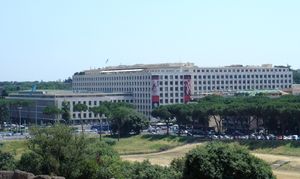
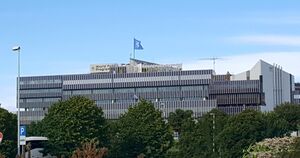
Among the global cities, Rome is unique in having two sovereign entities located entirely within its city limits, the Holy See, represented by the Vatican City State, and the territorially smaller Sovereign Military Order of Malta. The Vatican is an enclave of the Italian capital city and a sovereign possession of the Holy See, which is the Diocese of Rome and the supreme government of the Roman Catholic Church. For this reason, Rome has sometimes been described as the capital of two states.[87][88] Rome, therefore, hosts foreign embassies to the Italian government, to the Holy See, to the Order of Malta and to certain international organisations. Several international Roman Colleges and Pontifical Universities are located in Rome.
The Pope is the Bishop of Rome and its official seat is the Archbasilica of Saint John Lateran (of which the President of the French Republic is ex officio the "first and only honorary canon", a title held by the heads of the French state since King Henry IV of France). Another body, the Sovereign Military Order of Malta (SMOM), took refuge in Rome in 1834, due to the conquest of Malta by Napoleon in 1798. It is sometimes classified as having sovereignty but does not claim any territory in Rome or anywhere else, hence leading to dispute over its actual sovereign status.
Rome is the seat of the so-called "Polo Romano"[89] made up by three main international agencies of the United Nations: the Food and Agriculture Organization (FAO), the World Food Programme (WFP) and the International Fund for Agricultural Development (IFAD).
Rome has traditionally been involved in the process of European political integration. The Treaties of the EU are located in Palazzo della Farnesina, the seat of the Ministry of Foreign Affairs, because the Italian government is the depositary of the treaties. In 1957 the city hosted the signing of the Treaty of Rome, which established the European Economic Community (predecessor to the European Union), and also played host to the official signing of the proposed European Constitution in July 2004.
Rome is the seat of the European Olympic Committee and of the NATO Defense College. The city is the place where the Statute of the International Criminal Court and the European Convention on Human Rights were formulated.
The city hosts also other important international entities such as the IDLO (International Development Law Organisation), the ICCROM (International Centre for the Study of the Preservation and Restoration of Cultural Property) and the UNIDROIT (International Institute for the Unification of Private Law).
العلاقات الدولية
المدن الشقيقة
Since 9 April 1956, Rome is exclusively and reciprocally twinned only with:
 Paris, France, 1956
Paris, France, 1956
- Solo Parigi è degna di Roma; solo Roma è degna di Parigi. (in إيطالية)
- Seule Paris est digne de Rome; seule Rome est digne de Paris. (in فرنسية)
- "Only Paris is worthy of Rome; only Rome is worthy of Paris."[90][91][92][93][94]
علاقات أخرى
Rome's other partner cities are:[95]
 Achacachi, Bolivia
Achacachi, Bolivia Algiers, Algeria
Algiers, Algeria Beijing, China[96][97]
Beijing, China[96][97] Belgrade, Serbia
Belgrade, Serbia Brasília, Brazil
Brasília, Brazil Buenos Aires, Argentina
Buenos Aires, Argentina القاهرة، مصر
القاهرة، مصر Cincinnati, United States
Cincinnati, United States Kyiv, Ukraine
Kyiv, Ukraine Kobanî, Syria[98]
Kobanî, Syria[98] Kraków, Poland[99]
Kraków, Poland[99] Madrid, Spain[100]
Madrid, Spain[100] Multan, Pakistan[101]
Multan, Pakistan[101] New Delhi, India
New Delhi, India New York City, United States[102]
New York City, United States[102] Plovdiv, Bulgaria
Plovdiv, Bulgaria Seoul, South Korea[103][104]
Seoul, South Korea[103][104] Sydney, Australia
Sydney, Australia Tirana, Albania[105][106]
Tirana, Albania[105][106] Tehran, Iran
Tehran, Iran Tokyo, Japan[107]
Tokyo, Japan[107] Tongeren, Belgium
Tongeren, Belgium Tunis, Tunisia[108]
Tunis, Tunisia[108] Washington, D.C., United States[109]
Washington, D.C., United States[109]
انظر أيضا
- References to Rome in Coptic Literature - Coptic Scriptorium database
الهامش
- ^ أيضاً مدينة الڤاتيكان
- ^ This hypothesis originates from the Roman Grammarian Maurus Servius Honoratus. However, the Greek verb descends from the Proto-Indo-European root *srew- (compare Ancient Greek ῥεῦμα (rheûma) 'a stream, flow, current', the Thracian river name Στρυμών (Strumṓn) and Proto-Germanic *strauma- 'stream'; if it was related, however, the Latin river name would be expected to begin with **Frum-, like Latin frīgeō 'to freeze' from the root *sreyHg-) and the Latin verb from *h₃rew-.
- ^ This hypothesis originates from Plutarch.
المصادر
وصلات خارجية
- Comune of Rome (in إيطالية)
- APT (official Tourist Office) of the City of Rome (in إنگليزية)
- Rome Museums – official site. Archived 1 يونيو 2017 at the Wayback Machine (in إنگليزية).
- Capitoline Museums (in إنگليزية)
 Geographic data related to روما at OpenStreetMap
Geographic data related to روما at OpenStreetMap
 وسائط متعلقة بـروما من مشاع المعرفة.
وسائط متعلقة بـروما من مشاع المعرفة.
| سبقه |
Landmarks of Rome | تبعه Aurelian Walls |
- ^ أ ب "Romulus and Remus". Britannica.com. 25 November 2014. Archived from the original on 17 March 2015. Retrieved 9 March 2015.
- ^ أ ب "I numeri di Roma Capitale" (PDF). Comune di Roma. 31 December 2018. Archived (PDF) from the original on 4 May 2020. Retrieved 4 May 2020.
- ^ أ ب "Popolazione residente al 1° gennaio". Archived from the original on 8 April 2020. Retrieved 10 April 2020.
- ^ "Principal Agglomerations of the World". Citypopulation. January 2017. Archived from the original on 4 July 2010. Retrieved 6 April 2012.
- ^ "What is the smallest country in the world?". History.com (in الإنجليزية). Archived from the original on 27 September 2018. Retrieved 27 September 2018.
- ^ "Why Is Rome Called The Eternal City?". 27 September 2021. Archived from the original on 16 September 2021. Retrieved 16 September 2021.
- ^ Beretta, Silvio (2017). Understanding China Today: An Exploration of Politics, Economics, Society, and International Relations. Springer. p. 320. ISBN 9783319296258.
- ^ B. Bahr, Ann Marie (2009). Christianity: Religions of the World. Infobase Publishing. p. 139. ISBN 9781438106397.
- ^ R. D'Agostino, Peter (2005). Rome in America: Transnational Catholic Ideology from the Risorgimento to Fascism. Univ of North Carolina Press. ISBN 9780807863411.
- ^ Heiken, G., Funiciello, R. and De Rita, D. (2005), The Seven Hills of Rome: A Geological Tour of the Eternal City. Princeton University Press.
- ^ "Old Age in Ancient Rome – History Today". Archived from the original on 12 June 2018.
- ^ Stephanie Malia Hom, "Consuming the View: Tourism, Rome, and the Topos of the Eternal City", Annali d'Igtalianistica 28:91–116 JSTOR 24016389
- ^ Andres Perez, Javier (2010). "Approximación a la Iconografía de Roma Aeterna" (PDF). El Futuro del Pasado. pp. 349–363. Archived from the original (PDF) on 23 September 2015. Retrieved 28 May 2014.
- ^ Giovannoni, Gustavo (1958). Topografia e urbanistica di Roma (in الإيطالية). Rome: Istituto di Studi Romani. pp. 346–347.
- ^ "Rome, city, Italy". Columbia Encyclopedia (6th ed.). 2009. Archived from the original on 24 March 2010.
- ^ "World's most visited cities". CNN. Archived from the original on 7 March 2016.
- ^ "Historic Centre of Rome, the Properties of the Holy See in that City Enjoying Extraterritorial Rights and San Paolo Fuori le Mura". UNESCO World Heritage Centre. Archived from the original on 24 February 2011. Retrieved 8 June 2008.
- ^ "Rome chosen as seat of Euro-Med Assembly secretariat – Italy". 13 July 2018. Archived from the original on 2 December 2018. Retrieved 2 December 2018.
- ^ "Cinecittà: Dream Factory" (in الإنجليزية). 23 March 2015. Archived from the original on 18 April 2019. Retrieved 20 May 2019.
- ^ Livy (1797). The history of Rome. George Baker (trans.). Printed for A.Strahan.
- ^ Cf. Jaan Puhvel: Comparative mythology. The Johns Hopkins University Press, Baltimore and London 1989, p. 287.
- ^ Claudio Rendina: Roma Ieri, Oggi, Domani. Newton Compton, Roma, 2007, p. 17.
- ^ "Weatherbase: Historical Weather for Rome, Italy". Weatherbase. 2007. Retrieved 2007-04-07.
- ^ "Colosseum: The Largest Amphitheatre". Guinnesworldrecords.com. 6 March 2013. Archived from the original on 27 October 2014. Retrieved 12 June 2018.
- ^ أ ب Eyewitness Travel (2006), pp. 36–37.
- ^ "Green Areas". RomaPerKyoto.org. Archived from the original on 4 February 2008. Retrieved 9 November 2008.
- ^ Frontin, Les Aqueducs de la ville de Rome, translation and commentary by Pierre Grimal, Société d'édition Les Belles Lettres, Paris, 1944.
- ^ Italian Gardens, a Cultural History, Helen Attlee. Francis Lincoln Limited, London 2006.
- ^ "Chasing Obelisks in Rome". Initaly.com. Archived from the original on 6 February 2010. Retrieved 3 February 2010.
- ^ "7 Free Things To Do In Rome". roundtheworldmagazin.com. 12 January 2017. Archived from the original on 17 February 2017. Retrieved 17 January 2017.
- ^ "The Bridges of Ancient Rome". Citrag.it. Archived from the original on 13 January 2010. Retrieved 3 February 2010.
- ^ "Sant'Angelo Bridge". Encyclopædia Britannica. Archived from the original on 9 January 2010. Retrieved 3 February 2010.
- ^ "The World According to GaWC 2020". www.lboro.ac.uk. Archived from the original on 3 May 2017. Retrieved 18 July 2019.
- ^ "2014 Global Cities Index and Emerging Cities Outlook". Archived from the original on 17 April 2014. Retrieved 2 August 2014.
- ^ أ ب ت "Rapporto Censis 2006". Censis.it. Archived from the original on 18 April 2008. Retrieved 3 February 2010.
- ^ "Observatoribarcelona.org". Archived from the original on 6 August 2007.
- ^ أ ب "La classifica dei redditi nei comuni capoluogo di provincia". Il Sole 24 ORE. Archived from the original on 12 May 2011. Retrieved 14 June 2010.
- ^ "World's richest cities in 2009". City Mayors. 22 August 2009. Archived from the original on 12 June 2010. Retrieved 14 June 2010.
- ^ "Global city GDP 2011". Brookings Institution. Archived from the original on 5 June 2013.
- ^ DeCarlo, Scott (30 March 2006). "The World's 2000 Largest Public Companies". Forbes. Archived from the original on 13 January 2007. Retrieved 16 January 2007.
- ^ "Roman Academies". Catholic Encyclopedia. Newadvent.org. 1 March 1907. Archived from the original on 12 January 2010. Retrieved 3 February 2010.
- ^ "Anholt-GfK Roper Nation Brands Index" (PDF). wayback.archive-it.org. 18 December 2017. Archived from the original on 17 December 2008.
{{cite web}}: CS1 maint: unfit URL (link) - ^ "Top 100 European Universities". Academic Ranking of World Universities. 2005. Archived from the original on 29 January 2009.
- ^ "Top 100 Universities". Center for World University Rankings. 2013. Archived from the original on 13 December 2019. Retrieved 22 August 2019.
- ^ "Top 100 European Universities". Academic Ranking of World Universities. 2008. Archived from the original on 21 May 2009. Retrieved 22 August 2019.
- ^ "LUISS School of Government". sog.luiss.it (in الإيطالية). Archived from the original on 10 July 2019. Retrieved 22 August 2019.
- ^ "The American University of Rome". The American University of Rome. Archived from the original on 28 January 2013. Retrieved 4 February 2013.
- ^ "Temple Rome Study Abroad". Temple University. Archived from the original on 1 February 2013. Retrieved 4 February 2013.
- ^ "About the NAC". Pontifical North American College. Archived from the original on 25 August 2010. Retrieved 1 October 2010.
- ^ Amedeo Benedetti, La Biblioteca della Società Geografica Italiana, "Biblioteche oggi", n. 3, aprile 2009, p. 41.
- ^ Max Planck Gesellschaft e.V (17 May 2006). "Max Planck Society – Hanno and Ilse Hahn Prize". Mpg.de. Archived from the original on 13 June 2008. Retrieved 25 January 2010.
- ^ "LA NEW HOLLYWOOD: IL CONTESTO POLITICO-SOCIALE". Unife.it (in الإيطالية). Università degli Studi di Ferrara. Archived from the original on 25 January 2021. Retrieved 2021-01-31.
- ^ "The 50 Most Visited Places in The World". itvnews.tv. 2 October 2009. Archived from the original on 2 October 2009. Retrieved 22 August 2019.
- ^ "AIRC-HC Program in Archaeology, Classics, and Mediterranean Culture". Romanculture.org. Archived from the original on 29 March 2010. Retrieved 3 February 2010.
- ^ "Isvroma.it". Isvroma.it. Archived from the original on 18 April 2008. Retrieved 3 February 2010.
- ^ James E. Packer (January–February 1998). "Trajan's Glorious Forum". Archaeology. Vol. 51, no. 1. Archaeological Institute of America. Archived from the original on 16 February 2010. Retrieved 2 October 2010.
- ^ I H Evans (reviser), Brewer's Dictionary of Phrase and Fable (Centenary edition Fourth impression (corrected); London: Cassell, 1975), p. 1163
- ^ Miller, Francis Trevelyan; Wilson, Woodrow; Taft, William Howard Taft; Roosevelt, Theodore (1915). America, the Land We Love. W. T. Blaine. p. 201. OCLC 679498513. Archived from the original on 28 July 2020. Retrieved 22 August 2019.
- ^ Toynbee, J.M.C. (December 1971). "Roman Art". The Classical Review. 21 (3): 439–442. doi:10.1017/S0009840X00221331. ISSN 0009-840X. JSTOR 708631. S2CID 163488573.
- ^ "Baroque Art of Rome (ROME 211)". Trincoll.edu. Archived from the original on 30 May 2008. Retrieved 3 February 2010.
- ^ Matt Rosenberg. "Grand Tour of Europe: The Travels of 17th & 18th Century Twenty-Somethings". About.com. Archived from the original on 5 December 2010. Retrieved 3 February 2010.
- ^ "The Franca Camiz Memorial Field Seminar in Art History". Trinity College, Hartford Connecticlt. Archived from the original on 30 May 2008. Retrieved 3 February 2010.
- ^ da Silva, José (28 March 2022). "Visitor Figures 2021: the 100 most popular art museums in the world—but is Covid still taking its toll?". The Art Newspaper. Retrieved 16 January 2023.
- ^ "Maxxi_Museo Nazionale Delle Arti Del Xxi Secolo". Maxxi.beniculturali.it. Archived from the original on 11 February 2010. Retrieved 25 March 2010.
- ^ "Auditorium Parco della Musica". Auditorium.com. Archived from the original on 23 March 2010. Retrieved 25 March 2010.
- ^ Pelati, Manuela (30 September 2015). "Eur spa, Diacetti: «La nuvola di Fuksas sarà completata entro il 2016". Corriere della Sera (in الإيطالية). Archived from the original on 8 December 2015. Retrieved 5 December 2015.
- ^ "The Global Language Monitor » Fashion". Languagemonitor.com. 20 July 2009. Archived from the original on 1 November 2009. Retrieved 17 October 2009.
- ^ "Fendi". fendi.com. Archived from the original on 31 January 2010. Retrieved 17 October 2009.
- ^ "Packs Of Ravenous Wild Boars Are Ransacking Rome". NPR (in الإنجليزية). Associated Press. 2021-09-28. Retrieved 2022-04-11.
- ^ Rolland, Jacques (2006). The food encyclopedia. Toronto: Robert Rose. p. 273. ISBN 0-7788-0150-0. OCLC 70176309.
- ^ أ ب ت ث Eyewitness Travel (2006), pg. 312 - 313
- ^ Piras, Claudia (2000). Culinaria Italy. Culinaria Konemann. p. 291. ISBN 3-8290-2901-2. OCLC 881159457.
- ^ Carnacina, Luigi; Buonassisi, Vincenzo (1975). Roma in Cucina (in الإيطالية). Milano: Giunti Martello.
- ^ "Cinecittà, c'è l'accordo per espandere gli Studios italiani" (in الإيطالية). 30 December 2021. Retrieved 10 September 2022.
- ^ "History of Cinecittà Studios in Rome". Romefile. Archived from the original on 1 May 2009. Retrieved 17 October 2009.
- ^ "The Literary Arena, Remembering the poetry of Augustan Rome". Lapham's Quarterly. July 31, 2019. Retrieved 1 February 2022.
- ^ Ostler, N. (2007). Ad Infinitum: A Biography of Latin. London: HarperCollins. ISBN 978-0-8027-1679-8.
- ^ "Eurostar Italia Alta Velocità". 3 December 2006. Archived from the original on 3 December 2006.
- ^ "Statistiche Dati di Traffico Aeroportuale Italiano". Assaeroporti (in الإيطالية). Retrieved 2023-02-21.
- ^ "Porti di Roma". Archived from the original on 7 March 2015. Retrieved 6 March 2015.
- ^ Kiefer, Peter (30 November 2007). "Central Rome Streets Blocked by Taxi Drivers". The New York Times. Archived from the original on 17 April 2009. Retrieved 10 February 2008.
- ^ Dyson, Stephen L. (2019). Archaeology, Ideology and Urbanism in Rome from the Grand Tour to Berlusconi. Cambridge University Press. p. 192. ISBN 978-0-521-87459-5. Archived from the original on 23 May 2020. Retrieved 22 August 2019.
- ^ Kington, Tom (14 May 2007). "Roman remains threaten metro". Guardian. London. Archived from the original on 31 August 2013. Retrieved 10 August 2008.
- ^ "Metro C, apre la Pantano-Centocelle: folla di romani all'inaugurazione". Il Messaggero (in الإيطالية). 9 November 2014. Archived from the original on 11 November 2014. Retrieved 11 November 2014.
- ^ "ATAC". atac.roma.it (in الإيطالية). Archived from the original on 6 January 2012. Retrieved 22 August 2019.
- ^ Webb, Mary (2009). Jane's Urban Transport Systems 2009–2010. Coulsdon: Jane's Information Group. ISBN 978-0-7106-2903-6. OCLC 316826596.
- ^ "Discorsi del Presidente Ciampi". Presidenza della Repubblica. Archived from the original on 21 September 2013. Retrieved 17 May 2013.
- ^ "Le istituzioni salutano Benedetto XVI". La Repubblica. Archived from the original on 2 March 2013. Retrieved 17 May 2013.
- ^ "parlamento.it" (PDF). Archived from the original (PDF) on 2 April 2015.
- ^ "Gemellaggio Roma – Parigi – (1955)" (PDF). Roma – Relazioni Internazionali Bilaterali (in الفرنسية). Paris: Commune Roma. 30 January 1956. Archived from the original on 9 July 2016. Retrieved 10 September 2016.
- ^ "Dichiarazione congiunta Roma – Parigi – (2014)" (PDF). Roma – Relazioni Internazionali Bilaterali (in الفرنسية). Rome: Commune Roma. 1 October 2014. Archived from the original on 9 July 2016. Retrieved 10 September 2016.
- ^ "Twinning with Rome". Archived from the original on 5 September 2012. Retrieved 27 May 2010.
- ^ "Les pactes d'amitié et de coopération". Mairie de Paris. Archived from the original on 11 October 2007. Retrieved 14 October 2007.
- ^ "International relations: special partners". Mairie de Paris. Archived from the original on 6 August 2007. Retrieved 14 October 2007.
- ^ "Comune di Roma". Commune of Rome. Archived from the original on 2 December 2020. Retrieved 18 November 2020.
- ^ "Sister Cities". Beijing Municipal Government. Archived from the original on 18 August 2012. Retrieved 23 June 2009.
- ^ "Le jumelage avec Rome" (in الفرنسية). Municipalité de Paris. Archived from the original on 16 December 2008. Retrieved 9 July 2008.
- ^ "Rome declares Kobane 'sister city'". Archived from the original on 21 December 2016. Retrieved 18 December 2016.
- ^ "Kraków – Miasta Partnerskie" [Kraków – Partnership Cities]. Miejska Platforma Internetowa Magiczny Kraków (in البولندية). Archived from the original on 2 July 2013. Retrieved 10 August 2013.
- ^ "Mapa Mundi de las ciudades hermanadas". Ayuntamiento de Madrid. Archived from the original on 26 May 2012. Retrieved 17 October 2009.
- ^ Jaffery, Owais (9 June 2011). "Sister cities: Multan celebrates Italy's national day". The Express Tribune. Pakistan. Archived from the original on 25 February 2021. Retrieved 29 February 2020.
- ^ "NYC's Partner Cities". The City of New York. Archived from the original on 14 August 2013. Retrieved 16 December 2012.
- ^ "International Cooperation: Sister Cities". Seoul Metropolitan Government. www.seoul.go.kr. Archived from the original on 10 December 2007. Retrieved 26 January 2008.
- ^ "Seoul – Sister Cities [via WayBackMachine]". Seoul Metropolitan Government (archived 2012-04-25). Archived from the original on 25 March 2012. Retrieved 23 August 2013.
- ^ "Twinning Cities: International Relations" (PDF). Municipality of Tirana. www.tirana.gov.al. Archived from the original (PDF) on 10 October 2011. Retrieved 23 June 2009.
- ^ Twinning Cities: International Relations. Municipality of Tirana. www.tirana.gov.al. Retrieved on 25 January 2008.
- ^ "Sister Cities(States) of Tokyo". Tokyo Metropolitan Government. Archived from the original on 11 June 2016. Retrieved 17 June 2019.
- ^ "Cooperation Internationale" (in الفرنسية). 2003–2009 City of Tunis Portal. Archived from the original on 8 May 2008. Retrieved 31 July 2009.
- ^ "Visita a Washington del Sindaco". Archived from the original on 25 November 2011. Retrieved 3 October 2011.
- Pages using gadget WikiMiniAtlas
- صفحات بها مخططات
- Short description is different from Wikidata
- Articles containing إيطالية-language text
- Articles containing إتروسكية-language text
- Pages using Lang-xx templates
- Articles containing لاتينية-language text
- Pages using infobox settlement with possible nickname list
- Coordinates on Wikidata
- Articles containing إنگليزية-language text
- صفحات تستخدم جدول مستوطنة بقائمة محتملة لصفات المواطن
- Articles containing OSM location maps
- Articles with hatnote templates targeting a nonexistent page
- Wikipedia articles in need of updating from May 2018
- All Wikipedia articles in need of updating
- Pages using multiple image with auto scaled images
- Articles with إيطالية-language sources (it)
- Articles with فرنسية-language sources (fr)
- Pages with empty portal template
- Articles with إنگليزية-language sources (en)
- Cities and towns in the Lazio
- Communes of the مقاطعة روما
- المدن المضيفة للألعاب الاولمبية الصيفية
- Rome
- Ancient city of Rome
- Capitals in Europe
- Metropolitan City of Rome Capital
- Catholic pilgrimage sites
- Holy cities
- Places in the deuterocanonical books
- New Testament cities
- Populated places established in the 8th century BC
- 8th-century BC establishments in Italy
- World Heritage Sites in Italy
- روما
- مدن ذات أهمية دينية مسيحية
- مواقع التراث العالمي في إيطاليا
- صفحات مع الخرائط
- CS1 الإيطالية-language sources (it)
- CS1: Julian–Gregorian uncertainty
- CS1 maint: unfit URL
- CS1 الفرنسية-language sources (fr)
- CS1 البولندية-language sources (pl)




